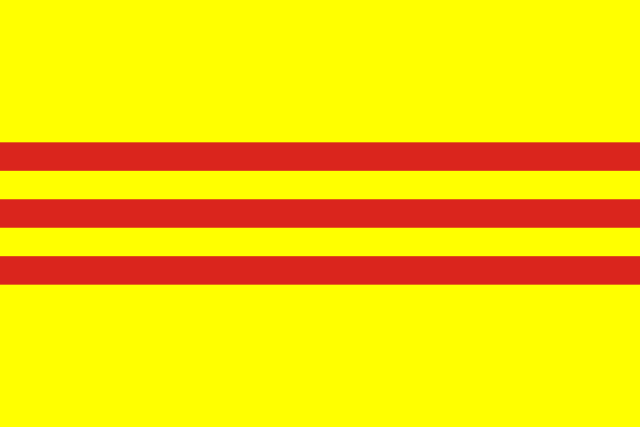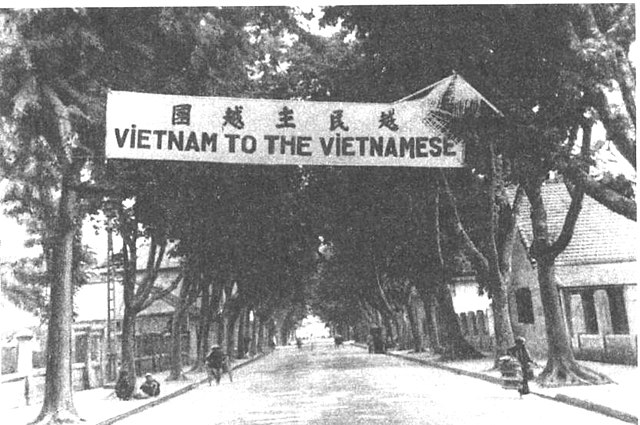Top Qs
Timeline
Chat
Perspective
Vietnamese nationalism
Form of nationalism regarding the Vietnamese people and nation From Wikipedia, the free encyclopedia
Remove ads
Vietnamese nationalism (Vietnamese: chủ nghĩa dân tộc Việt Nam, or chủ nghĩa quốc gia Việt Nam) is a form of nationalism that asserts the Vietnamese people as a separate independent nation. It encompasses a broad range of ideas and sentiments harbored by the Vietnamese people in regards with national identity.[citation needed]


Some modern nationalist concepts in Vietnam focused on China, where anti-Chinese sentiment in Vietnam had been fueled in various forms, from South China Sea disputes, to cultural and historical grievances, and at some stage, finding Mongolian and Manchurian rule "less civilised" or had to repel against several dynasties from the north, housing Song and Ming refugees due to these empires.[1][2] Nationalism that promoted anti-French[3] views had also been prominent in the past. Vietnam's current government propaganda is also regarded as a synthesis of socialism and nationalism.[4] Long periods of foreign domination has also created the fear that Vietnam may be "reconquered", which also tends to serve as fuel for Vietnamese nationalism.[5][6]
Remove ads
History
Summarize
Perspective
Prehistoric
Semi-mythical figures such as the Hùng kings prior to Chinese rule in southern China and northern Vietnam from 2879 BC – 258 BC played a role in shaping Vietnam as a separate nation in the modern era. Such origin myths were exploited by the Viet elite as early as the 15th century as a catalyst for identity formation and unification under an imperial state. Under French rule and the early national period, these myths were integrated into the official historiography of Đại Việt.[7]
Nationalist historiography
The historiography of Vietnam under Chinese rule has had substantial influence from French colonial scholarship and Vietnamese postcolonial national history writing. During the 19th century, the French promoted the view that Vietnam had little of its own culture and borrowed it almost entirely from China, which was mostly wrong as Vietnamese culture emerged initially Austroasiatic and Vietic. They did this to try to justify European colonial rule in Vietnam. By portraying the Vietnamese as merely borrowers of civilization, the French colonisers situated themselves in a historical paradigm of "bringing civilization" to a "backwards region" of the world. French scholar Leonard Aurousseau argued that not only did Vietnam borrow culturally and politically from China, the population of Vietnam was also directly the result of migration from the state of Yue in China. This line of thought was followed by Joseph Buttinger, who authored the first English language history book on Vietnamese history. He believed that to fight off the Chinese, the Vietnamese had to become like the Chinese.[8]
The national school of Vietnamese history, portrays the period in "a militant, nationalistic, and very contemporary vision through which emerged a hypothetical substratum of an original Vietnam that was miraculously preserved throughout a millennium of the Chinese presence."[8] The national Vietnamese narrative depicts the Chinese as a corrupt and profit-driven people and merely the first of the foreign colonizing empires that were eventually driven from Vietnam. According to Catherine Churchman, this is not an entirely new historical tradition but a rewriting or updating of it, and has roots in Đại Việt, which portrayed itself as the Southern Empire equal to the Northern Empire (China). Đại Việt literati of the Trần and Lê dynasties sought an ancient origin for their autonomy prior to Chinese rule and traced their genealogy to Triệu Đà or the semi-legendary Hồng Bàng dynasty. They recorded that the Northern Empire suffered defeat for not respecting these views. However, scholars such as Nhi Hoang Thuc Nguyen argue that "the trope of a small country consistently repelling the China's cultural force is a recent, postcolonial, mid-20th-century construction".[1][9] Publishing in 2024, Academics Xinru Ma and David C. Kang describe the nationalist narrative of struggle with China for autonomy as a meme.[10]: 59 Ma and Kang write that this nationalist narrative "is a recent, twentieth-century nationalist narrative that was originated during a time of Vietnamese colonization by France and that was later aimed at uniting Vietnamese in struggles against larger imperial powers, including the United States."[10]: 59
Works by Japanese scholars in the 1970s as well as in the English language in the 1980s have taken on elements of the national school. Katakura Minoru's Chūgoku shihaika no betonamu emphasizes the innate characteristics of the Vietnamese people. Keith Taylor's The Birth of Vietnam (1983) asserts a strong continuity from the semi-legendary kingdoms of the Red River Plain to the founding of Đại Việt, which was the result of a thousand-year struggle against the Chinese that culminated in the restoration of Vietnamese sovereignty. Jennifer Holmgren's The Chinese Colonisation of Northern Vietnam uses Sinicization and Vietnamization as terms to refer to political and cultural change in different directions. Works following the national school of Vietnamese history retroactively assign Vietnamese group consciousness to past periods (Han-Tang era) based on evidence in later eras. The national school of Vietnamese history has remained practically unchanged since the 1980s and has become the national orthodoxy.[11]
The argument for an intrinsic, intractable, and distinctly Southeast Asian Vietnamese identity in the Red River Plain throughout history has been categorized by Catherine Churchman as context, cultural continuity, and resistance.[12] Context refers to the downplaying of similarities between Vietnam and China while emphasizing Vietnam's Southeast Asian identity in the postcolonial period. Cultural continuity refers to an intrinsic Vietnamese "cultural core" that has always existed in the Red River Plain since time immemorial . Resistance refers to the national struggle of the Vietnamese people against foreign aggressors. Proponents of this historical narrative, such as Nguyen Khac Vien, characterize the history of Vietnam under Chinese rule as a "steadfast popular resistance marked by armed insurrections against foreign domination", while opponents such as Churchman note the lack of evidence, anachronisms, linguistic problems, adherence to Chinese political and cultural norms, and similarities as well as differences with other peoples under Chinese rule.[13]
The Vietnamese national narrative has introduced anachronisms in order to prove a unified Vietnamese national consciousness. The word Viet/Yue is often used to refer to an ethnic group when it had various meanings throughout history. There was no terminology to describe a Chinese-Vietnamese dichotomy during the Han-Tang period nor was there a term to describe a cohesive group inhabiting the area between the Pearl River and the Red River.[14] During the Tang period, the indigenous people of Annan or Jinghai Circuit were referred to as the Wild Man (Wild Barbarians), the Li, or the Annamese (Annan people).[15][16] In addition, the national history tends to have a narrow view limited to modern national boundaries, leading to conclusions of exceptionalism. Although it is true that the political situation in the Red River Plain was less stable than in Guangzhou to the north, such circumstances were not restricted to the area. The Vietnamese national narrative retroactively assigns any local rebellions, the rise of local dynasties, and their local autonomy with the motive of seeking national independence.[17] Language has also been used as evidence for a distinct Vietnamese identity in the Han-Tang period. However, some research points to the formation of a Vietnamese language only afterward as the result of a creolization and language shift involving Middle Chinese.[12]
Nam tiến
Beginning in the 20th century under the auspices of nationalism and racialism, modern Vietnamese historiography coined the term nam tiến for what they believed to be a gradual, inevitable southern expansion of Vietnamese domains.[18][19] The nam tiến became one of the dominant themes of the narrative that Vietnamese nationalists created in the 20th century, alongside an emphasis on non-Chinese origin and Vietnamese homogeneity.[20]: 7 Within Vietnamese nationalism and Greater Vietnam ideology, it served as a romanticized conceptualization of the Vietnamese identity, especially in South Vietnam and modern Vietnam.[21]
During the Nam tiến period of the Nguyễn dynasty, Emperor Gia Long stated that "Hán di hữu hạn" (漢夷有限, "the Vietnamese and the barbarians must have clear borders") when differentiating between Khmer and the Vietnamese.[22] Emperor Minh Mạng, the son of Gia Long, stated with regards to the Vietnamese forcing the ethnic minorities to follow Sino-Vietnamese customs that "We must hope that their barbarian habits will be subconsciously dissipated, and that they will daily become more infected by Hán [Civilised] customs."[23] The Nguyễn dynasty under that influence once saw themselves as "Hán nhân" (Civilised people).[24][25]
Vietnamese anti-colonial period


After French started to rule Vietnam (French Indochina), Vietnamese nationalism became driven by a sense of anticolonialism as evidence of French atrocities in Vietnam emerged.[26] The French sought to introduce Christianity to Vietnam, but the religion was viewed with suspicion from the rulers and French missionaries were executed, leading to war between France and Vietnam and eventual conquest of Vietnam under France.[27] Initially, there were attempts to "modernise" Vietnam with Western ways of thinking via France.[28] However, the oppressive colonial rule created a divide between the bourgeoises and the oppressed peasant class of Vietnam, causing leaders such as Ho Chi Minh to oppose French colonial rule, and found communism enticing during his time abroad, believing that it could be used to liberate the Vietnamese people.[29] Although Ho Chi Minh remains revered and controversial to this day, there were arguments that Ho Chi Minh was fundamentally a Vietnamese nationalist turned to communism.[30][31][32][33][34] A combination of French colonialism, followed by temporary Japanese occupation, and attempted French colonialism again further spurred Vietnamese nationalism and finally independence from foreign powers.[35]
Vietnam War and the Modern era
During the Vietnam War (1955–75), Vietnamese nationalism was split between Chinese and Soviet-allied North Vietnam and US and Western-backed South Vietnam.[36] Controversies continue to this day due to political differences, including the fact that communist symbols or the current Vietnam flag raised controversies within the South Vietnamese overseas diaspora, whilst the South Vietnam flag is disparaged in Communist-controlled Vietnam.[37][38]
Remove ads
Modern Vietnamese nationalism

Economy
There has been a growing movement among Vietnamese by boycotting Chinese products, using Vietnamese-made products instead, or tending to prefer Japanese or Western-made products over Chinese products. "Made in China" can be seen as mass-produced cheap products but sometimes also of inferior quality.[39] The China-United States trade war since 2018 has also made other countries a beneficiary of the trade war.[40][41][42]
Territorial
The contentious South China Sea disputes (called "East Sea" in Vietnam) can become a flashpoint for nationalism to emerge.[43] In 2023, the Barbie movie was banned over alleged drawings resembling the 9 dash or 11 dash line.[44]
Remove ads
See also
References
Further reading
External links
Wikiwand - on
Seamless Wikipedia browsing. On steroids.
Remove ads
